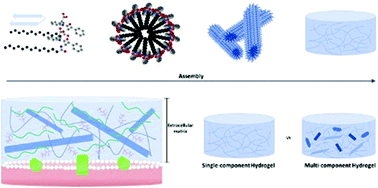Multi-component peptide hydrogels – a systematic study incorporating biomolecules for the exploration of diverse, tuneable biomaterials†
Abstract
Peptide-based supramolecular gels can be designed to be functional “smart” materials that have applications in drug delivery, tissue engineering, and supramolecular chemistry. Although many multi-component gel systems have been designed and reported, many of these applications still rely solely on single-component gel systems which limits the functionalities of the materials. Multi-component self-assembly leads to the formation of highly ordered and complex architectures while offering the possibility to generate hydrogels with interesting properties including functional complexity and diverse morphologies. Being able to incorporate various classes of biomolecules can allow for tailoring the materials’ functionalities to specific application needs. Here, a novel peptide amphiphile, myristyl-Phe-Phe (C14-FF), was synthesized and explored for hydrogel formation. The hydrogel possesses a nanofiber matrix morphology, composed of β-sheet aggregates, a record-low gelation concentration for this class of compounds, and a unique solvent-dependent helical switch. The C14-FF hydrogel was then explored with various classes of biomolecules (carbohydrates, vitamins, proteins, building blocks of HA) to generate a multi-component library of gels that have potential to represent the complex natural extracellular matrix. Selected multi-component gels exhibit an excellent compatibility with mesenchymal stem cells showing high cell viability percentages, which holds great promise for applications in regenerative therapy.



 Please wait while we load your content...
Please wait while we load your content...